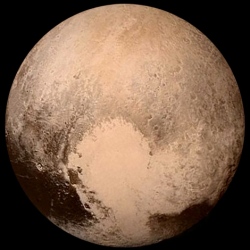
Last July the space probe New Horizons made humanity’s first flyby of Pluto and glimpsed a world stranger and far more complex than anyone had imagined. Rather than dull and dead, the dwarf planet is smattered with odd geographical features and, somehow, ongoing geological activity.
Today, we’ve learned even more about this weird world and its moons from the scientists trying to make sense of the discovery, who published the first detailed analysis of Pluto’s landscape, atmosphere, moons, chemistry, and its surprising interaction with solar wind. Outlined in five new papers published in the journal Science, scientists have their first hints at the origin of mysteriously complex landscape.
"This was the human race’s first visit to a planetary body living out in the Kuiper Belt, [the region beyond Neptune], so it’s an entirely new class of world," says Bill McKinnon, an astrophysicist at the University of Washington in St. Louis and deputy lead of the New Horizons Geology, Geophysics and Imaging team. "It turned out to be really crazy."
McKinnon co-authored the paper in today’s batch that’s an overview of the menagerie of geographical features found on Pluto. As McKinnon will tell you, there are a lot.
"Pluto has possible ice-volcanoes, cratered plains, crater-free frozen planes, rugged plains, etched and pitted canyons, glacial erosion, glacially suspended terrain, upright blades of ice, mountain ridges, motion flow-lines around obstacles, wall-to-wall craters covered with some red material that may be methane ice baked by radiation, broken assemblages of water-ice crust assembled together like logs in a jam, big bands of land that are tracked with what looks like the arms of saguaro cactus," McKinnon says. "Should I keep going?"
He says these features place Pluto, once considered just a lonely ice-ball in the dark, on par with Mars (and second only to Earth) in terms of geological complexity. So what’s causing Pluto’s wacky, varied landscape?
New Horizons has shown that Pluto is continually shaped and carved by ices, not just water ice, "but some quite exotic," says McKinnon. Carbon dioxide ice, methane ice, and different nitrogen ices are present. These various ices have a wide range of melting, freezing, and evaporating temperatures.
The way that they move about in the extreme cold at different layers of Pluto’s surface, through melting, slipping, glaciating, and chemically transitioning straight from solid to gas, is an alien process to us, but one that cam at least partially explain why Pluto looks the way it does, and keeps changing.
"We’re only just now learning how these different ices work at these extremely low temperatures," says Fran Bagenal, an astrophysicist and New Horizons’ team leader at the University of Colorado. "This is a world radically different than anything we’ve seen before, so how these extremely cold ices can flow or not flow, or, say, form big chunky surfaces that act like rock, it’s all new."
